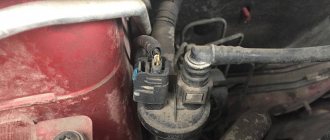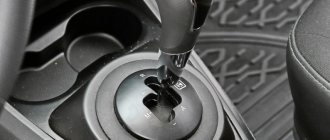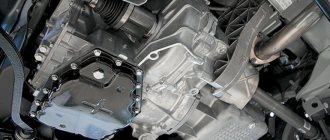Lada Vesta is equipped with one of two gasoline engines – 21129 (1.6 l.) or 21127 (1.8 l.). The control system is electronic. Initially, the operation of the computer and feedback sensors is finely tuned. However, over time, a problem arises - instability of speed at idle and while driving. Determining the exact cause is often difficult due to the fact that the Check Engine light does not light up, so scanning the ECU is useless. Still, you can identify the flaw of uncomfortable functioning on your own.
The theory of engine vibration at idle speed of Lada Vesta and possible causes
Theoretical aspects
The amount of air is regulated: the degree to which the gas pedal is pressed determines the opening angle of the throttle valve. Incorrect determination of the control system for the volume of the air mixture leads to the fact that the speed of the Lada Vesta floats at idle and while driving.
What causes the floating effect? The amount of gasoline sprayed into the manifold is calculated based on the volume of incoming air. When the computer perceives the latter incorrectly, the motor gains momentum. The degree of fuel injection remains the same, the mixture becomes leaner and the power plant begins to stall. The amount of oxygen and nitrogen mixture consumed is reduced, fuel consumption remains the same and is now sufficient - engine operation is stabilized. Then the cycle repeats.
Probable Causes
At this stage, it is clear that low-quality fuel can cause engine detonation, but not cause unstable idling. Untimely ignition of the fuel-air mixture can cause a negative effect. To eliminate the malfunction, a comprehensive inspection should be carried out:
- SU sensors.
- Regulator in the throttle assembly.
- Elements of the inlet assembly unit.
- Brake system units.
- Gasoline vapor recovery algorithm devices.
- Ignition systems.
Lada Vesta. POPING IN THE INLET PIPE
| List of possible faults | Diagnostics | Elimination methods |
| The clearances in the valve drive are not adjusted | Check valve clearances | Adjust the clearances in the valve drive |
| Intake valves sticking in the guide bushings: gum deposits on the surface of the valve stem or bushing, sediment or broken valve springs | Inspection during engine disassembly (STO) | Repair the engine (service station) |
| Disturbed valve timing | Check valve timing | Establish the correct relative position of the crankshaft and camshaft. Check compression |
Route map for identifying causes
Incorrect determination by the computer of the volume of air supplied to the combustion chamber, problems with the ignition system and an additional flow of gasoline vapor into the intake manifold of the Lada Vesta cause engine vibration at idle speed and operating modes. There are many reasons, so diagnosis should be done progressively. Check:
- Presence of air leaks in the intake pipe.
- The operation of the vacuum brake booster and the integrity of the connection between the tube and the input manifold.
- Canister valve.
- Throttle position sensors, absolute pressure and temperature sensors, idle air control.
- Integrity of wires and serviceability of ignition system coils.
I started seeing this problem. Sometimes there is a failure in power, that is, at FIRST you can’t turn it on until it slips (even with ESP turned off!), but if you turn off the engine and start it again, there is a possibility that the dynamics will return, the problem is floating and I don’t understand at all what it depends on. upd: I'm inclined to think that the pedal is being naughty.
upd: The switched-on speed limiter is to blame, it chokes the engine throughout the entire speed range, turn it off and everything is fine!
In order for the car to comply with more stringent environmental standards, AvtoVAZ equips modern Lada cars (Priora, Granta, Kalina, Niva, Largus, Vesta and XRAY) with an electronic gas pedal or “E-gas”. The throttle valve drive got rid of the cable and became equipped with a gear motor. As a result, the gas pedal has no mechanical connection with the throttle valve, and engine control has become completely electronic.
Lada Vesta (2019). The engine does not develop full power
Lada Vesta (2019). The engine does not develop full power
The car does not have sufficient throttle response. Jerks and dips when moving
| List of possible faults | Diagnostics | Elimination methods |
| The air filter element is clogged | Check the condition of the air filter replacement element | Blow or replace the air filter element |
| Increased resistance to gas movement in the exhaust system | Inspect the exhaust system for dented and damaged pipes, check the condition of the catalytic converter (back pressure) (service station) | Replace damaged exhaust system components |
| Suction of foreign air into the intake tract | Inspect the joints, check the fit of the throttle assembly, absolute pressure and air temperature sensors. Briefly disconnect the brake booster by plugging the intake manifold | Replace gaskets, O-rings, parts with deformed flanges, faulty vacuum booster |
| Incomplete throttle opening | Determined visually with the engine stopped | Adjust the throttle valve actuator |
| Low compression in the engine cylinders (less than 11.0 bar): wear or damage to valves, their guides and seats, stuck or broken piston rings | Check compression | Replace faulty parts |
| Disturbed valve timing | Check valve timing | Establish the correct relative position of the shafts. Check compression |
| The gaps between the electrodes of the spark plugs do not correspond to the norm | Check clearances | By bending the side electrode, set the required gap or replace the spark plugs |
| Heavy carbon deposits on the spark plug electrodes; ingress of carbon particles into the gap between the electrodes | Inspection | Check and replace spark plugs if necessary |
| Damage to the insulation of high-voltage devices and circuits | Using an ohmmeter, check for open or breakdown (short to ground) of the ignition coil windings and high-voltage wires | Replace damaged ignition coil, high-voltage wires |
| There is not enough fuel in the tank | By level indicator and fuel reserve indicator | Add fuel |
| The fuel filter is clogged, the water that has entered the power system is frozen, the fuel pipes are deformed | Check fuel system pressure | Replace the fuel filter. In winter, place the car in a warm garage and blow out the fuel lines. Replace defective hoses and tubes |
| The fuel pump does not create the required pressure in the system | Check the pressure in the fuel system, make sure the fuel module strainer is clean | Clean the fuel module strainer. Faulty fuel pump, pressure regulator, replace |
| Poor contact in the fuel pump power supply circuit (including ground wires) | Checked with an ohmmeter | Clean contacts, crimp wire ends, replace faulty wires |
| Faulty injectors or their circuits | Check the injector windings and their circuits with an ohmmeter (no open or short circuit) | Replace faulty injectors, ensure contact in electrical circuits |
| The air temperature sensor or its circuits are faulty | Check the sensor and its circuits | Restore contact in electrical circuits, replace the faulty sensor |
| The absolute air pressure sensor or its circuit is faulty | You can evaluate the performance of the absolute air pressure sensor using diagnostic equipment at a service station | Restore contact in electrical circuits, replace the faulty sensor |
| The oxygen concentration sensor is faulty | You can evaluate the performance of the oxygen concentration sensor and the reliability of its electrical circuit connections using diagnostic equipment at a service station | Restore damaged electrical circuits. Replace faulty sensor |
| The ECU or its circuits are faulty | To check the ECU, replace it with a known good one. | Replace the faulty ECU |
| The clearances in the valve drive are not adjusted | Check valve clearances | Adjust the clearances in the valve drive |
| Severe wear on the camshaft cams | Inspection during engine disassembly at a service station | Replace the worn camshaft at a service station |
| Loose or broken valve springs | Inspection during engine disassembly | Have the engine repaired at a service station |
| The throttle position sensor or its circuit is faulty | Check the throttle position sensor | Restore contact in electrical circuits, replace the faulty sensor |
| Coolant temperature sensor faulty | Check the sensor resistance at different temperatures with a tester | Restore contact in electrical circuits, replace the faulty sensor |
The engine does not develop full power
You need to pay attention to the loss of engine power when it goes beyond the 15 percent mark and if the car (in good condition) accelerates with difficulty on a flat, dry and hard road. There are plenty of reasons for this phenomenon, since in a machine, as in a living organism, everything is interconnected. The most common causes of power loss in a power unit Early ignition
One of the elementary reasons for a decrease in engine power can be early ignition. In this case, the force of the exhaust gases goes against the movement of the piston due to the fact that the fuel mixture ignites prematurely. As a result, the engine cannot develop its full power. Delayed ignition also negatively affects vehicle speed. Here, on the contrary, the fuel mixture does not have time to burn until the moment when the piston reaches the dead center and the resulting energy is far from being fully used. The third reason may lie in a malfunction of the vacuum ignition timing regulator. Engine speed directly depends on how well the carburetor throttle valves are open. If the regulator diaphragm is damaged, it begins to function with great difficulty or fails altogether, which, in fact, immediately affects the power of the power unit
Also, the centrifugal ignition timing regulator may be to blame for the reduction in engine power, a malfunction of which leads to the problem described. As the engine speed increases, the centrifugal regulator begins to increase the ignition timing, but if its weights jam, the angle does not change throughout the entire operation of the engine and it loses its power. In this case, excessive fuel consumption is often observed due to early ignition, which occurs due to the rapid stretching of the weight springs. It is impossible to imagine the normal operation of the engine, and, accordingly, the combustion chambers, without the valves being tightly seated in the seats intended for them. Depending on the type of engine, the gap between the pusher shim and the end of the rod must be of a certain size. If the gap is increased, the tightness of the combustion chamber is compromised, which significantly reduces engine power. And with a reduced clearance, the valve edges and seats usually burn out. You can determine a loose fit by the shots: if a shot goes into the carburetor, this means that the intake valve does not fit tightly, and if a shot goes into the muffler, it means that the exhaust valve is not tight enough. Last but not least on the list is the cause of worn piston rings. In this situation, compression in the cylinders decreases, which immediately affects engine power. It is quite easy to determine whether rings are worn out. To do this, you need to remove the crankcase ventilation hose from the breather and if smoke comes out from there, it means the rings are worn out. The smoke resembles a dark stream with a pulse. Insufficient filling of the cylinders with the working mixture
But what could be the reason for the decrease in engine power when the ignition is adjusted and the ignition timing regulators are working properly? In this case, you should check that the cylinders are full of the working mixture. Most often, this problem occurs due to the throttle valve sticking, so you sometimes need to pay attention to its drive. After this, you need to check the serviceability of the air filter, which, if necessary, is quickly removed and a new one is installed in its place. As practice has shown, a lack of working mixture in the cylinders can occur for four reasons: excessive carbon deposits in the engine cylinders; large deposits of coke and tar in the inlet pipe; sticking in the needle valve float chamber; using fuel with an octane number that does not match the number prescribed by the instructors.
Poor working mixture
The entry of a lean working mixture into the cylinders is also one of the reasons for the reduction in engine power. There are a number of reasons for the formation of a lean mixture, which can be eliminated fairly quickly: Air leaks at the junction of carburetor elements due to damage to the gaskets or due to loose fastenings. Transmission can be detected using soap suds. Where suction occurs, a void (window) is usually formed. Air leakage is removed by tightening the bolts and replacing sealing gaskets where required. Other reasons may be freezing of the liquid in the power system, contamination of the channels and jets in the carburetor, or contamination of the fuel lines. The situation can be corrected by blowing out the jets, fuel lines and channels using an ordinary pump used to inflate tires. If blowing does not give the proper result, then the carburetor must be disassembled and cleaned with copper wire. Clogging of the fuel pump air hole, wear of its drive lever and sticking of the air damper are the reasons for the formation of a lean mixture for the cylinders. These malfunctions are eliminated by replacing all non-working components of the fuel pump with new ones, cleaning the plug hole, and adjusting, if necessary, the length of the cable that controls the air damper. A small diaphragm breakthrough, sticking of the fuel pump valves and contamination of the strainer help create a working mixture. Problems are removed by washing the filter, restoring or replacing the diaphragm and eliminating stuck valves. It is worth knowing that sometimes a decrease in engine power occurs due to the influence of weather conditions. So, for example, in winter this problem occurs due to icing of the carburetor, and in summer the car loses speed due to a vapor lock or worn-out fuel pump. It turns out that the car owner can fix half of the problems on his own, but if there is no confidence in the correctness of his actions, then it is better to entrust this work to real professionals working at the service station.
Other reasons
Why doesn't the engine develop full power?
Lean mixture entering the cylinders. Filling the cylinders with a lean mixture always leads to a significant reduction in engine power. In this case, the car moves at reduced speeds; it takes more time to accelerate on a dry road with a hard and smooth surface when the vehicle’s chassis mechanisms are in good technical condition. The reasons for the formation of a lean mixture are the following: clogged jets and channels in the carburetor, contamination of fuel lines, freezing of water in the power system. In this case, it is necessary to blow out the jets, channels and contaminated fuel lines using a tire inflation pump, and if necessary, clean them with copper wire by disassembling the carburetor; stuck fuel pump valves, clogged strainer or ruptured diaphragm. In this case, first remove the stuck fuel pump valves, wash the strainer, and replace the broken diaphragm or temporarily restore it in the manner described earlier; air leakage at the junction of carburetor parts, carburetor flange with exhaust pipe, intake pipe flanges with cylinder block due to loose fastenings, as well as damage to gaskets. The location of the leak can be detected using soap suds. A window will form in the soap suds at the expected location of the leak. Air leaks are eliminated by tightening nuts or bolts, as well as replacing the corresponding sealing gaskets; wear of the fuel pump drive lever, clogging of the air hole connecting the fuel tank to the atmosphere, jamming of the air damper. These malfunctions are eliminated as follows: replace faulty parts of the fuel pump, clean the air hole of the plug, check and, if necessary, adjust the length of the carburetor choke control cable. Late ignition. If the engine does not develop full power, then it is best to check the ignition installation. If the ignition is too late, the engine loses throttle response. A significant reduction in power occurs because the mixture does not have time to burn at the moment when the piston is at TDC. Combustion of the mixture continues as the piston moves downwards. This is evidenced by increased heating of the exhaust pipeline. It will be too hot because some of the mixture will burn when released.
Early ignition. A decrease in engine power also occurs when ignition is too early, when the combustible mixture ignites prematurely and the force of the gases acts against the piston, which moves towards TDC. At the same time, frequent and loud metallic knocks are heard in the engine, detonation may occur, the engine does not work well at low crankshaft speeds, and when started with the crank, it sometimes gives back knocks. If by adjusting the ignition timing using the methods discussed earlier, it is not possible to achieve the desired results, then, obviously, malfunctions have arisen in the devices for automatically adjusting the ignition timing - centrifugal or vacuum regulators.
The vacuum ignition timing regulator is faulty. On the way, the car has to move both on a flat road and on a road with inclines. Let's assume that when driving at a constant speed both on a flat road and on an uphill road, the centrifugal regulator will only provide the same ignition timing. But when driving on a hilly road, the engine load and throttle opening are much greater, so the ignition timing must be less than when driving on a flat road at the same speed.
Violation of clearances in the valve mechanism. It is known that a tight fit of the valve in the seat, i.e. its complete closure, is ensured due to the thermal gap in the valve mechanism. If the normal values of thermal clearances established by the requirements of the factory operating instructions for vehicles are violated, the engine loses power. With small gaps, valves and their seats burn out. The presence of large gaps in the valve mechanism causes not only a loss of engine power, but also a characteristic metallic knocking sound of the valves. In addition, loose closure of, for example, an exhaust valve due to abnormal clearances is characterized by “shots” in the muffler, and a loose fit of the intake valve is characterized by “sneezing” in the carburetor. Both small and large clearances in the valve mechanism negatively affect not only the efficiency of the engine, but also the service life of its parts. Abnormal clearances in the valve mechanism are adjusted in the manner discussed earlier. Wear of piston rings. Piston rings provide a tight seal between the piston and cylinder, preventing gases from escaping into the engine crankcase, and also prevent oil from penetrating into the combustion chamber. When the piston rings wear out (burning of the rings in the piston grooves, loss of their elasticity), compression in the cylinders sharply decreases, which leads to loss of engine power, increased oil and gasoline consumption; Black smoke comes out of the muffler. Compression in the engine cylinders is checked using a compression gauge and manually.
Contamination of the muffler. During the operation of the car, due to the engine running on a too rich mixture, incomplete combustion occurs. Unburnt fuel is thrown out in the form of soot, and part of it settles on the inner wall of the muffler, gradually contaminating it. In addition, contamination of the muffler is also possible when the vehicle is carelessly reversing on a bumpy dirt road. If the muffler is dirty, the engine loses power. The condition of the muffler can be determined by external inspection and a light blow from the outside. A clean muffler produces a high-pitched metallic sound, while a dirty muffler produces a dull sound. A dirty muffler must be cleaned, as this leads not only to loss of engine power, but also to excessive consumption of gasoline, as well as premature wear of the muffler.
Operating principle of the electronic pedal
A gearbox, an electric motor and two sensors are built into the throttle body. The electric motor turns the throttle valve through a gearbox, and its position is monitored by two sensors.
The electronic gas pedal is a plastic lever, and two sensors are installed in the bracket. All elements are a single structure (gas pedal module). The sensors are potentiometers, the moving contact of which is rigidly connected to the rotary axis of the pedal lever.
electronic gas pedal Lada Priora, Granta, Kalina, Vesta electronic gas pedal Lada Priora, Granta, Kalina
The electronic control unit (ECU) continuously monitors the pedal position based on sensor signals. Based on these parameters, the ECU sends control commands to the throttle gearbox and to the fuel injectors.
Lada Vesta. INCREASED OIL CONSUMPTION (OVER 500 G PER 1000 KM)
| List of possible faults | Diagnostics | Elimination methods |
| Oil leakage through: crankshaft and camshaft oil seals; oil pan, cylinder head gaskets; oil pressure sensor; oil filter o-ring | Wash the engine, then after a short drive, inspect for possible leaks. | Tighten the fastening elements of the cylinder head, cylinder head cover, oil pan, replace worn oil seals and gaskets |
| Wear and loss of elasticity of oil seals (valve seals). Wear of valve stems, guide bushings | Inspection of parts when disassembling the engine | Replace worn parts |
| Wear, breakage or coking (loss of mobility) of the piston rings. Wear of pistons, cylinders | Inspection and measurement of parts after engine disassembly | Replace worn pistons and rings. Bore and hone the cylinders |
| Using oil of inappropriate viscosity | — | Change the oil |
| The crankcase ventilation system is clogged | Inspection | Clean the ventilation system |
content .. 1 2 3 5 ..
Malfunctions of the electronic gas pedal
Moving contacts and conductive paths are subject to wear, which makes their signals incorrect. As a result, the engine will operate unstably, “dips” will appear, and at idle the speed will “float”. If a malfunction occurs in the operation of E-gas, the Check Engine warning lamp on the instrument panel will light up, and the ECU will switch the system to a reserve mode of operation, in which the speed will increase slowly, even when the gas pedal is pressed sharply. Fuel consumption may also increase.
If both sensors fail, the ECU will switch the engine management system to emergency operation mode, the engine will only operate at speeds slightly above idle (1500 min-1). In this case, it is recommended to contact a service station to replace the failed parts under warranty.
Dips in the engine and a little about the interior
Good day!
Before Vesta, he operated Largus for three years. Cool car. The engine is elastic. The engine and gearbox made it possible to engage 5th gear already at 35-40 km/h and so slowly, as if on an automatic machine, move around the city in a wide speed range. The car was created, of course, not to “drive”, but to transport.
Vesta has a completely different engine. Loves speed. If you don't turn the engine up enough, you'll see failure. If you twist it, it will slip.
So. At first, up to 20 km/h and don’t hesitate to turn the engine. In the second up to 40, in the third from 40 and with moderate driving up to 60. Classic layout. There will definitely be no failures.
It is stupid to demand completely identical behavior from different cars. This is where I went wrong. The car has no business here. Today I stopped by the service station and agreed to lift the car after the holidays and see how well the suspension is stretched. I'll write back right away. If necessary, I'll post a photo.
Climate. Fogging of glass.
The other day I went to Zarinsk, alone, 106 km from Barnaul. Overboard -35. The glass remained clean all the way. Halfway down the road I sat down a very heavy-set woman, very well wrapped up, it was cold after all. She sat in the back seat. So very soon the glass of the door where she was sitting began to fog up. Then it gradually went away. The climate is constantly turned on at +22. I didn’t manage the deflectors in any clever way. Today, immediately after washing, the whole family went out of town. The car was not properly ventilated after the dampness of the wash. I look - the rear circuit is tightened. I turned on a quick warm-up of the interior and didn’t have time to “blow out” the car before we arrived at the place. It wasn't far to go. We were visiting for about two hours. When I went out to warm up the car (it was -25 outside) I was expecting icy rear windows. To my surprise, I didn’t find anything like that; all the glass was clean. It’s even strange to myself. We need to repeat it.
I am posting a photo of the instrument panel, where you can see the number of revolutions at 90 km/h in 5th gear.
Now ABOUT THE INCONVENIENCES. I have a question for the AvtoVAZ designers - is it possible to make the armrest retractable? I can barely fit my elbow on it and then it slides off. In my Largus I installed an armrest with a glove compartment that is much more convenient than this one. If it's just a box for small items, then let's call it that.
And further. I can't get the seat belt into the lock. Even from the photo, I think you will see how awkwardly it is installed. Now let's take into account that winter also constrains clothing. Now we still need to rummage somewhere between the armrest and the seat, to find this lock.
However, all this is not critical and not fatal... Most likely I will not pay attention to this soon.
Jerks, jerking of Lada Vesta and pressure in the fuel rail
Tired spark plugs, decrepit high-voltage wires, cracks in the corrugation of the intake manifold - all this can be checked and replaced simply. And immediately evaluate the result. However, in most cases, Lada Vesta owners complain that such manipulations are useless.
General diagram of the Lada Vesta fuel system. 1 – fuel rail; 2, 3, 4, 5 – fuel line; 6 – fuel module; 7 – gas tank.
The problem with VAZ engines 21129 and 21179 is insufficient pressure in the fuel rail . Here's the thing. Everyone knows that the path of gasoline from the gas tank to the cylinders looks like this:
In short, yes. We pay special attention to the second point of this list.
There are nuances here, since for a 1.8-liter engine the normal fuel pressure in the rail is 3.80 atm, and for a 1.6-liter engine it is 3.50 atm.
Cases have been observed where the wrong pressure regulators were installed from the factory in the fuel modules for both engines; the maximum that could be obtained from measurements was 3.60 atm in the ramp.
Naturally, with such pressure there is no way to talk about any correct work. And this is an even better option. In some cases, the pressure regulator made it possible to maintain only 2.7-2.85 atm at idle. Hence the dips and jerking when accelerating.
A pressure of 3.5 bar is generally considered normal, according to officials.
The main disappointment in the car: A motorist spoke about the problems with the 1.6 106 hp engine in the LADA Vesta
The VAZ engine is the anchor that prevents Vesta from becoming a modern car.
Photo: LADA Vesta 1.6, source: m.auto.ru
The main complaint about the 1.6-liter VAZ-21129 engine with a power of 106 horsepower, designed and assembled by AvtoVAZ, is its archaic nature. This opinion was shared by a motorist on the YouTube channel “LADA Vesta Blog” after 4 years of ownership. But even this LADA Vesta has its advantages.
Archaic and problematic “129th”
Because of this, car owners have to face a lot of problems:
New LADA Vesta FL 2021-2022: What is known about restyling today
LED optics, a tablet a la Tesla in the cabin and a more powerful engine - these are the innovations the updated Vesta will boast. The platform and overall design have not changed, but many cosmetic ones have appeared.
Among the advantages of the “anchor”, motorists note its reliability, provided that the oil, filters and timing kit are changed in a timely manner. The engine surprises with its service life, reaching 300-400 thousand km without capital. The maintainability, simplicity and low cost of servicing the unit is enviable.
The engine lends itself perfectly to “chipping” and boosting up to 130-150 “horses”, if you want to “experiment”.
Photo: Exterior, interior and engine of LADA Vesta 1.6 AMT, source: YouTube and LADA
However, the “newsman” noted that now, having experienced all the shortcomings of the “archaic” engine, he would take the Vesta with a 1.6-liter 113-horsepower unit from Renault paired with a CVT.
In addition, the constant “tugging” of the manual transmission lever is a thing of the last century; even the “blunting robot” is more progressive and provides more comfort than the “handle”.
Source
How to increase the pressure in the fuel system of Lada Vesta to normal
If we are sure that the injectors are working correctly and they are clean, and the fuel pump is able to create the necessary pressure, then all the blame for the current situation with failures and jerking lies only with the pressure regulator. Here he is.
The hero of today's celebration is the fuel pressure regulator (FPR).
There are two options - either replace the pressure regulator with a new one at 3.8 atm, or improve the old one at your own risk. Oddly enough, the last option gives the best results.
First, let's buy a new regulator and install it in place. This is done simply, but not too quickly ( we figured out how to remove the Lada Vesta fuel module here ):
If the replacement did not give anything (the pressure in the ramp did not increase, it remained at 3.50 atm), we will try to modernize the old regulator.
The regulator has a very simple design - it is a valve in a housing, loaded by a spring with a calculated force. The spring must create such a force that the valve opens no earlier than the electric fuel pump creates a pressure of 3.80 bar.
The force of the spring on the valve is regulated by the depth of the recess in the lower part of the regulator.
The depth of the standard recess is about 3 mm.
To increase the force (thereby forcing the valve to open a little later and provide higher pressure), it is enough to carefully shrink the central part of the bottom of the regulator body by a few millimeters.
To do this, we use available tools - a long bolt with a rounded end on sandpaper, a strong washer of suitable diameter, a vice and a hammer. As a rule, the recess depth of a standard regulator is no more than 3 mm.
We install the RTD on a vice through a spacer made of a washer and with a light, precise blow we seat the bottom a few more millimeters.
Ready. You can check the results of modifications to the fuel pressure regulator by measuring the pressure in the rail or simply by going for a test drive.
In most cases, such a modification eliminates jerks during acceleration, allows you to save a little fuel (this can be seen by the instantaneous consumption on the BC display) and solves the problem with failures in transient engine operating modes and in maximum power modes.
Source
Why does the Lada Vesta twitch, symptoms
Loss of power and even jerks when changing gears may well not be assessed very objectively. For example, with a manual transmission, an inept driver can shift in such a way that passengers feel overloads of 4g. But that's not what we're talking about now.
Failures in the operation of VAZ 21129 (1.6 l) and VAZ 21179 (1.8 l) cannot be called a generic disease, but the problem occurs quite often. However, symptoms of incorrect engine operation in transient modes can tell the mechanic a lot. And there are enough symptoms:
As you can see, there are enough symptoms and they are somewhat different, but the essence of the problem is the same - Vesta twitches, the engine runs rough.










